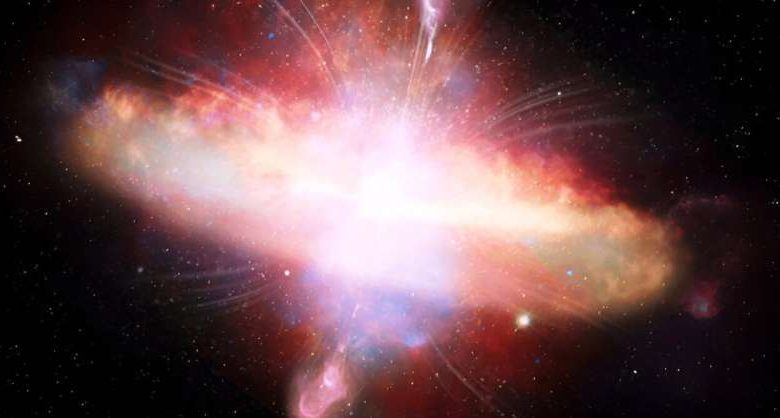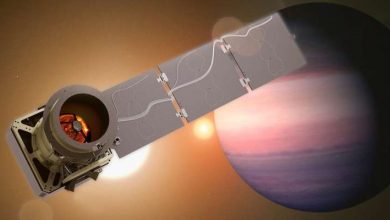Radio signals reveal secrets of hidden supermassive black holes

Astronomers have found a striking link between the amount of dust surrounding a supermassive black hole and the strength of the radio emission produced in extremely bright galaxies.
The team of international astronomers, led by Newcastle University and Durham University, U.K., used new data from the Dark Energy Spectroscopic Instrument (DESI), which is conducting a five year survey of large scale structure in the universe that will include optical spectra for ~3 million quasars; extremely bright galaxies powered by supermassive black holes.
They found that quasars that contained more dust, and therefore appeared redder, were more likely to have stronger radio emission compared to the quasars that had very little-to-no dust, appearing very blue. The findings are published in the Monthly Notices of the Royal Astronomical Society.
Almost every known galaxy contains a supermassive black hole, which are black holes with a mass millions to billions that of our sun, at its center, including our own Milky Way. In some galaxies there is lots of material in the center, feeding and growing this supermassive black hole, making it very energetic and “active.”
The most powerful type of these active galaxies are called “quasars,” which are some of the brightest objects in the universe. Most quasars appear very blue, due to the bright disk of matter that orbits and feeds the central supermassive black hole which is very bright in optical and ultraviolet wavelengths.
However, astronomers have found that a significant fraction of these quasars appear very red, although the nature of these objects is still not well understood.
In order to understand the physics of these red quasars, “spectroscopic” measurements are required, which can be used to analyze the quasar light at different wavelengths. The shape of the quasar’s spectrum can indicate the amount of dust present surrounding the central region. Observing the radio emission from quasars can also tell you about the energetics of the central supermassive black hole; whether it is launching powerful “winds” or “jets” that might shape the surrounding galaxy.
Understanding the mysteries of red quasars
This new study, led by Dr. Victoria Fawcett of Newcastle University, and previously Durham University, uses spectroscopic observations from DESI to measure the amount of dust (reddening) in a sample of ~35,000 quasars and link this to the observed radio emission. The researchers find that DESI is capable of observing much more extreme red (dusty) quasars compared to similar/previous spectroscopic surveys, such as the Sloan Digital Sky Survey (SDSS). They also find that redder quasars are much more likely to have strong radio emission compared to typical blue quasars.
Dr. Fawcett said, “It was really exciting to see the amazing quality of the DESI data and to discover thousands of these, previously rare, red quasars. I feel like this study puts lots of the puzzle pieces together in our understanding of red quasars and definitively links the dust in a quasar to its radio emission. I think this is the strongest evidence so far that red quasars are a key element in how galaxies evolve.”
This reddening-radio connection is likely due to powerful outflows of gas driven away from the supermassive black hole, which slam into the surrounding dust, causing shocks and radio emission. These outflows will eventually blow away all the dust and gas in the central region of the galaxy, revealing a blue quasar and resulting in weaker radio emission.
This is consistent with the emerging picture that red quasars are a younger, “blow-out” phase in the evolution of galaxies. Red quasars may therefore be extremely important for understanding how galaxies evolve over time.
Dr. Fawcett continues, “There are still many unanswered questions surrounding red quasars, such as whether black hole winds or radio jets are ultimately responsible for this enhanced radio emission. However, with the sample of DESI red quasars continuing to grow over the next few years of the survey, I am confident that we are on the brink of fully understanding the nature of these red quasars.”





